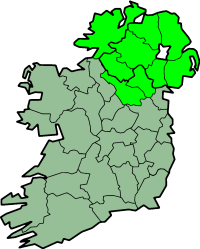Ulaid

The Ulaid[1] (pron. /'ʊləɣ′/) were a people of early north-eastern Ireland, who gave their name to the modern province of Ulster: modern Irish Cúige Uladh (pron. /'kuːiɡə 'ʊləɣ/), "Province" (literally "fifth") "of the Ulaid"; English "Ulster" derives from Ulaid plus Old Norse stadr, "place" or "territory". The earlier form of their name has been reconstructed as *Uluti, deriving from ul, "beard",[2] and appears as Volunti or Voluntii in Ptolemy's 2nd century Geographia.[3]
Their capital was traditionally at Navan Fort, (Irish Eamhain Mhacha) near Armagh. At their height, Ulaid territory extended south as far as the River Boyne and as far west as County Leitrim. By early Christian times the northern Uí Néill (a branch of the Connachta) has pushed the Ulaid into to eastern County Down where they became known as the Dál Fiatach and the Dál nAraidi.
According to the Annals of the Four Masters, the reduction of the Ulaid began in AD 331, when the Three Collas defeated their king Fergus Foga in the Battle of Achadh Leithdheirg in County Monaghan. They seized all their territory west of the Newry River and Lough Neagh, and burned Emain Macha.[4] After that, Emain was abandoned, and Fergus Foga was the last Ulaid king to rule there.
The Dál Fiatach held on as kings of Ulster against further attacks by the Uí Néill, and were still ruling part of County Down, based at Downpatrick, until they were overwhelmed by the Normans in 1177. The Normans established the short-lived earldom of Ulster which was superseded after 1333 by the Clandeboye O'Neills. The first O'Neill king of Ulster was proclaimed in 1364.
T. F. O'Rahilly believed the Ulaid were a branch of the Érainn.[5] Their ruling dynasty claimed descent from the legendary king Rudraige.
The Ulster Cycle of Irish mythology concerns the heroes of the Ulaid and their wars against the Connachta. These stories are traditionally set around the time of Christ, which creates an apparent anachronism: the Connachta are traditionally said to have been the descendants of Conn Cétchathach, who is supposed to have lived several centuries later. Later stories use the name Cóiced Ol nEchmacht as an earlier name for the province of Connacht to get around this problem. However, the chronology of early Irish historical tradition is an artificial attempt by Christian monks to synchronise native traditions with classical and biblical history, and it is possible that historical wars between the Ulaid and the Connachta have been chronologically misplaced.[6]
References
- ^ Old Irish spelling Ulaid (nominative singular, genitive plural Ulad); modern Irish spelling Ulaidh (genitive plural Uladh, nominative singular Ultach)
- ^ Karl Horst Schmidt, "Insular P- and Q-Celtic", in Martin J. Ball and James Fife (eds.), The Celtic Languages, Routledge, 1993, p. 67
- ^ Ptolemy, Geographia 2.1
- ^ Annals of the Four Masters M331
- ^ T. F. O'Rahilly, Early Irish History and Mythology, Dublin Institute for Advanced Studies, 1946, p. 81
- ^ Francis J. Byrne, Irish Kings and High Kings, Four Courts Press, 2001, p. 50.
